BUFFALO IN THE PEARL
We flew low over rugged mountains and onward to Karamoja’s acacia-studded valleys. Christian Weth and Jumbo Moore of Uganda Wildlife Safaris greeted us on the dirt strip at Kidepo National Park and we quickly headed toward camp. Five minutes down the road, two old buffalo bulls arose from the shade of a stout camel-thorn, as if a greeting committee. These bulls were safely inside the Park, but we would see plenty of their brethren.
A couple days later, still in a slow gray dawn, we cruised past a small thicket and one of the trackers tapped urgently. Black forms in deep shadow, two buffalo bulls stared back, looking good, but too thick and still too dark to be sure.
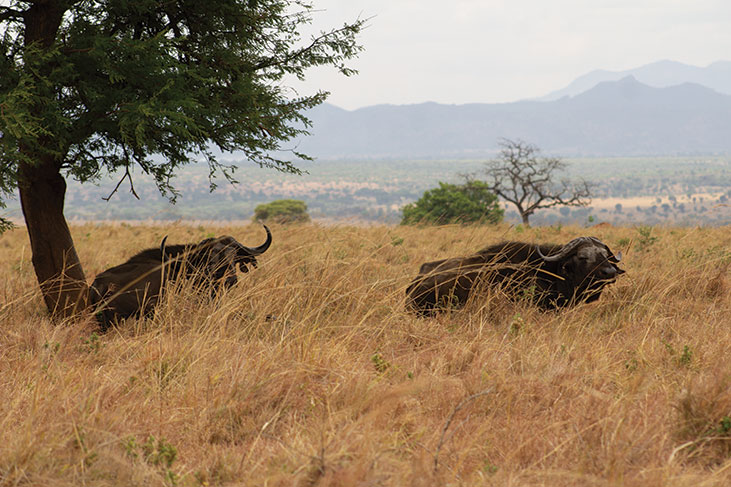
A short standoff ensued while the light grew, but the result was inevitable. Long before proper judgment could be made the bulls had enough and whirled, crashing out the back side of the black thorn, into open yellow grass toward the next thicket. As they galloped off, both still looked good, but “going away” is a poor angle for any animal, and impossible for buffalo.
We waited a bit to let them settle, then took up the tracks. Catching up with bachelor bulls spooked at close range can be a long process. But this was Karamoja; if we could get the wind right, we’d probably get another look.
The tracks took us into acacia forest, turning into the breeze, perfect. Running tracks changed to walking, then meandering as the bulls started to feed. In an hour we had black forms ahead, drifting among scattered trees. So, now commenced the most exciting phase of hunting the African buffalo, what I call “the approach.”
Partial views still suggested both these bulls were good, with plenty of horn showing outside the ears. Using termite mounds and stout acacias, we gained ground while the bulls fed slowly into the wind. Finally, Jumbo judged one bull too young, the bosses a bit soft in front. The second was fully mature with good shape.
This wasn’t my buffalo, so I hung back while Donna and Jumbo worked from cover to cover. They had the sticks up a half-dozen times until the older bull, definitely a keeper, finally stood at 70 yards, the younger bull directly behind. On sticks, Donna waited tensely until the younger bull moved off. The targeted bull stood frozen, staring at us, quartering to.
Donna took the shot with her Blaser .375 H&H with 2-7X Leupold and Hornady DGX. Impact looked good, the bull rocking back and turning away. Working the fast Blaser action, she followed up quickly and again, and her bull went down. His buddy stood guard for several minutes before finally trotting away.
A LONG ROAD BACK
In 1907, fresh from multiple wars and a brief career as a journalist, young Member of Parliament Winston Churchill said: “The kingdom of Uganda is a fairy-tale…truly the pearl of Africa.”
Until independence in 1962, Uganda remained a peaceful backwater between Sudan and Kenya. In the old days, Uganda was best-known for large numbers of elephants. The northeast region, home to the Karamojong people, gave ivory hunter Walter Bell his nickname. Northern Uganda was part of the Lado Enclave, claimed by Belgium’s King Leopold II. After Leopold’s death in 1909, authority was unclear, creating a free-for-all for ivory pirates.
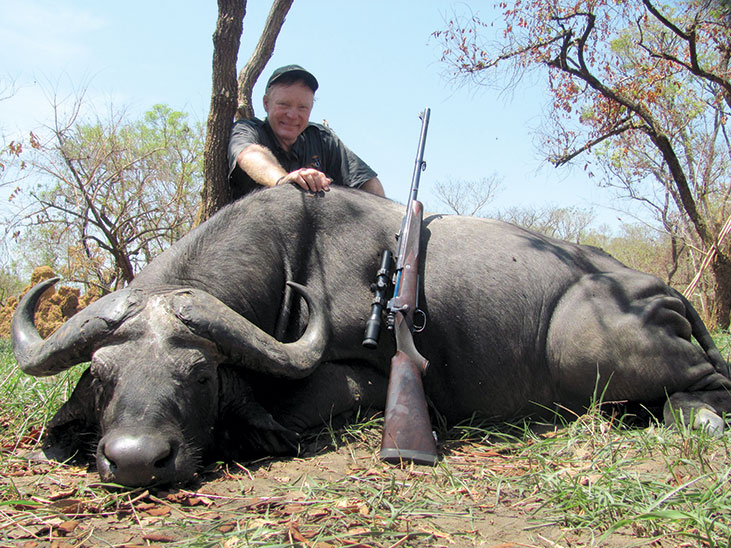
In December 1909, Theodore Roosevelt was there to hunt the northern white rhino. In 2011, I visited the area since known as “Rhino Camp,” where Roosevelt tactfully addressed a group of elephant hunters (really poachers) as a “company of gentleman adventurers.”
After independence, Uganda became a successful alternative to Kenya and Sudan. My old bosses, Bob Petersen and Tom Siatos, made their first safari there. On one of his last safaris, Robert Ruark used .275 Rigby owned by Walter Bell in Uganda. Petersen and Siatos hunted a full bag, while Ruark’s primary goal was a big leopard. Still, in the 1960s heavy-tusked elephants were Uganda’s primary draw, those days wonderfully chronicled in Brian Herne’s Uganda Safari (Winchester Press 1980).
Under Idi Amin’s brutal regime (1971-1979), safari hunting became untenable. In the mid-Seventies, I “shopped” Uganda as an option for my first safari, but I was too late. Like me, gunwriter Charles Askins was a buffalo nut. He hunted in Uganda, and I recall him extolling that the license offered five buffaloes!
Despite excellent variety, with heavy ivory the focus, populations and distribution of other game was little known. During the long civil war that followed Idi Amin, Uganda’s wildlife was devastated and there would be no safari hunting for 25 years.
Uganda’s rebirth as a safari country could be called a “soft opening.” A small country rich in agriculture with large human population, her elephants (and most wildlife) were eradicated from much of the country, leaving scattered pockets. Those enclaves and several marvelous National Parks remained game-rich. Even so, species diversity is not what it was, and animals “on license” are limited. Uganda is thus a specialized destination, but what is there is very good. Uganda is the only place currently where Jackson’s hartebeest, Nile buffalo, Nile bushbuck, and Uganda kob may be hunted. In my experience she is the best place for sitatunga and big East African impala, and buffalo hunting is excellent.
Safari hunting resumed in 2009. Since then, opportunities have expanded, but even now there are just a few outfitters. I hunted Uganda in 2011, 2017 and just now in March 2021, all with Uganda Wildlife Safaris. I saw conditions improve dramatically, with exponential wildlife increases. There is one thing: Uganda is Equatorial, so weather patterns are much different from the popular safari countries of southern Africa. At various times of the year, rains and high grass render some hunting near-impossible. My Uganda hunting has been in March, an ideal time, but I cannot speak to conditions at other times of year. Do your homework!
Churchill had it right. Uganda is gorgeous and her people are friendly, truly a pearl and her wildlife is increasing steadily. I can’t imagine what it might have been like in the Sixties, but modern Uganda holds some of the best buffalo hunting I have seen.
EXACTLY WHICH BUFFALO?
Donna’s buffalo was an old bull, yet with long tips still sharp, big bosses showing wear, exactly 40-inches in spread, with deep curve yielding exceptional length by our SCI scoring system. With equal spread but more curve, her bull measured better than the bull I took a few days later. Both were great buffaloes for anywhere in Africa, but not the best possible in Karamoja. In 2017 friend Mike Adams came into the same Karamoja camp with a monster 47-incher, and while we were just there Tim Herald took a heavy-bossed bull right at 44 inches. I’ve seen wider bulls there, but too young, with bosses not yet fully hard.
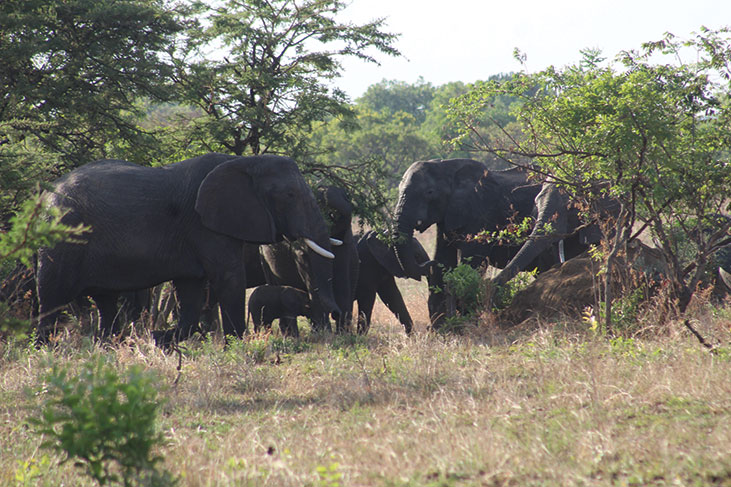
If you aren’t interested in African buffalo, I guess you should quit reading. But, since I’m obsessed by them, please indulge me. We define the buffaloes of northern Uganda as Nile buffalo, likewise those in Sudan. The Nile buffalo starts the gradual westward transition that concludes with the dwarf forest buffalo, small and red, with short, separated horns that curve out and up from the skull.
The Nile buffalo is just the beginning, so differences are subtle. I’ve taken five Nile buffaloes and seen many more. I think they are smaller than most southern Cape bulls—but how many are actually weighed? More significant: While mature bulls are usually black, every herd of Nile buffalo I have seen contains animals that are various shades of red, brown and even tan.
When looking for a good buffalo (of any race), we focus on the bulls, with an eye to horn shape and size. Our SCI minimum for southern Cape buffalo is 100 points/inches, measured by overall horn length around the curve from tip to tip, “bridging” the forehead gap. For Nile buffalo, the minimum is 70, a huge difference. Many dwarf forest and East, Central and West African savanna buffaloes do not have a defined “boss,” the helmet-like growth where horn bases nearly come together. The Nile buffalo usually does. However, in all horned animals, there is hidden length in curve, and Nile buffalo bulls most typically have “flat” horns that grow straight out, with little “drop” before curving upward into sharp tips.
Our SCI Record Book states that Nile buffalo horns almost never drop below the jawline. However, as smaller-horned buffaloes, they also rarely achieve as much spread, or bosses as thick, as southern Cape buffalo. The problem is that tricky word “almost,” and also understanding the geography of Uganda.
In any record-keeping system, we must draw lines somewhere, and animals don’t always understand our boundaries. Southeast Uganda is Lake Victoria. Southwest Uganda is bordered by Rwanda and Tanzania, where buffaloes are southern Cape. North of the lake and Kampala lies a heavily farmed region, with limited wildlife habitat. This is where the great sitatunga hunting lies…but there are no buffalo! In the northwest, primarily in and around the Murchison Falls National Park, there are lots of Nile buffalo.
In the Park, I’ve photographed awesome Nile bulls, sometimes with huge bosses…but almost always “flat” with minimal “drop.” Just now, in Murchison Falls, I photographed an ancient buffalo bull with so much drop he looked like a muskox! Nile buffalo “almost never” have horns that drop below the jawline!
On a good day in Murchison Falls you can see dozens of Nile buffalo bulls. Width rarely exceeds the mid-thirties, and a bull with exceptional drop is as uncommon as a unicorn. In the hunting areas on the west side, a bull achieving 70 inches/points is a great Nile buffalo, likewise in Sudan when hunting was possible.
Let’s shift northeast to the Karamoja District, just south of Sudan and west of Kenya. I know nothing about the buffalo up in northwest Kenya, Turkana country, but they are the northernmost buffalo that we call “southern Cape.” Just across the line into Uganda, it’s appropriate to call Karamoja buffalo “Nile,” but they’re different from the buffalo of northwest Uganda, across hundreds of kilometers where no buffalo roam.
In Southern Africa, not all buffalo bulls have horns that drop before turning up. However, this is a desirable characteristic because of beauty and added length in the curve. In Karamoja, most bulls are flat, like Nile buffaloes are supposed to be. However, buffaloes vary. Some Karamoja bulls have horns that drop, with a lot of curve. Others have significant spread, but any Nile buffalo with drop, curve and spread into the 40s is unusual, and will measure well.
GOOD ENOUGH, CLOSE ENOUGH!
In Karamoja, Walter Bell’s elephants are stable, now about 500, and seen frequently. Buffalo in Kidepo National Park number above 10,000, a huge concentration. Depending on time of year, it seems to me there is more water in the hunting areas to the south than in the park itself. That depends on rain and grass but, in March, I’ve never seen buffalo hunting like Karamoja.
There are herds, but also lots of bachelor groups. The herds have good bulls, but there’s no point in bothering them; look for the dagga bulls. Old buffalo bulls aren’t dumb, but it appears to me there must be almost no poaching. Lots of bulls, and as calm as I have ever seen.
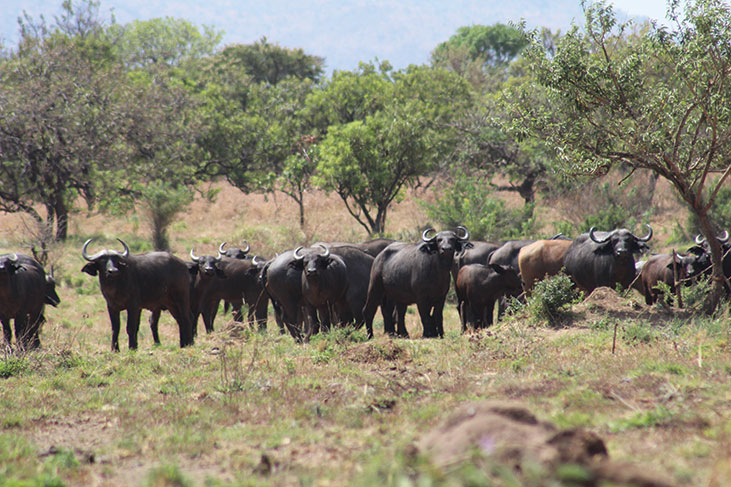
Add: The country is fairly open. There are thickets, but in the main the area is short-grass savanna with scattered acacias. You can look over bulls carefully, and then approach. Sort of like the buffalo hunting I’ve I read about but have rarely seen.
I have often recommended that we are better off hunting buffalo with scope-sighted rifles. That’s never a bad decision, but the buffalo hunting we dream about ends in a shot from behind a termite mound at 40-yards. That can happen anywhere but, in my experience, usually doesn’t. Across Africa, I figure the average shot on buffalo is 60 to just over 100 yards, pushing it for iron sights. However, it’s hard to escape the romantic idea that buffalo should be hunted with iron sights. And, despite aging eyes and limited familiarity with irons, many of us have open-sighted big-bores we’d like to use on buffalo.
The bulls of Karamoja are different from anything else I’ve encountered. I can’t properly explain it, other than a mix of little pressure and predation. Hey, it doesn’t always work, because cover is limited, but this is an area where buffalo can often be approached to “open sight range.”
In 2011 I hunted buffalo in the Aswa-Lolim area north of Murchison Falls. Buffaloes there are classic Nile, little drop, extreme spread unlikely. However, the big difference, that area is a Park boundary hunt; you take the shot you can get. The old bull I shot could have been taken with open sights, but that’s not predictable. Not understanding Karamoja, when I first hunted there in 2017, I used an Aimpoint red-dot sight on a .375, nice compromise between irons and scope.
It worked great, but optical sights weren’t necessary for the buffaloes I saw taken. You can’t always get close. However, if you have an open-sighted big bore—or wish to experience the close-range buffalo hunting we’ve read about—Karamoja is a place where you can use irons without giving up too many shots or sacrificing horn quality.
Since I’m a “gun guy,” the rifle I use is an important part of the hunt. Especially on buffalo since, these days, I look for an old bull, not necessarily the “biggest and best.” With a near-constant parade of bachelor bulls moving in and out of Kidepo, Karamoja is a wonderful place to look for nasty old dagga bulls with broken horns, and also for good bulls, take your pick and see what you find, which is what we did.
The most important criteria: Always, a mature bull! On this safari, also a buffalo that allowed a close shot with the rifle I wanted to use. It was a 1906 William Evans .470 that I know for sure resided in Uganda between 1907 and 1910, but most likely had not been back to Africa since. Secretly, I was hoping for a “scrum cap,” an ancient bull with both horns worn back almost to the bosses, worthless for record book score, but the ultimate to serious buffalo hunters. We never saw one, and had just quick glimpses of two old, broken-horned bulls, almost as good, but both gave us the slip.
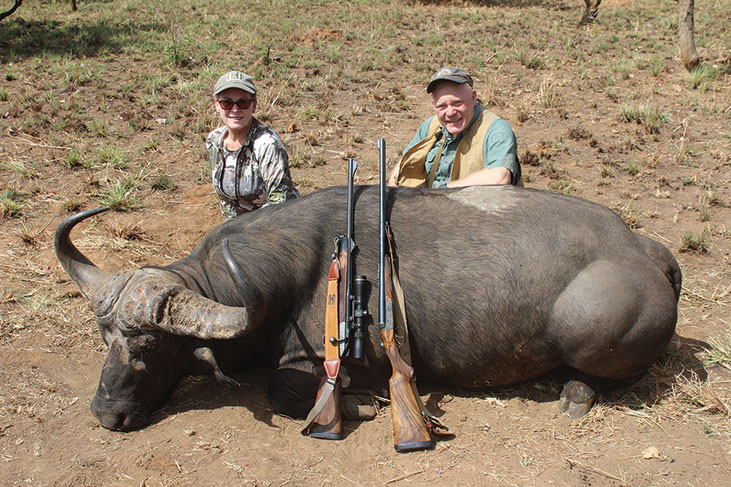
Instead, we saw a procession of well-shaped, beautiful bulls. As usual, mostly too young. There was one wide, heavy-horned old bull, but he was close to the Kidepo boundary and headed that way, so we left him. Amazingly, we saw another “muskox,” giant in body, with horns that dropped straight down and turned out well below the jaw. I’d have taken him if I could have, and I sure wish I’d gotten a photo. In Karamoja, he was the exception: Wild and wary. Tracking, we jumped him three times and never had a chance.
We looked for him the next day, but never saw him, and then it was time to do business. Shortly after sunrise, not far from camp, we saw a beautiful bull grazing, good shape, fully hard bosses. Jumbo drove away from him, got the wind right, and we organized quickly and stalked back. At 60 yards I had him quartering to, on sticks, safety off. I was just starting to press the front trigger when he turned away, put his head down, and resumed feeding. Jumbo grabbed the sticks and we walked up his backside, gaining another 25 yards. When he swung around the shoulder was black and huge, a wonderful close encounter, but that’s Karamoja!–Craig Boddington

